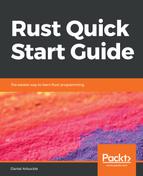In this guide, we're going to learn the basics of working with Rust, a systems-level programming language that has been making a name for itself over the last few years. Rust is a strict language, designed to make the most common errors impossible and less common errors obvious.
Being a systems-level language means that Rust is guided by the needs of low-level programs that don't have a safety net, because they are the safety net for higher-level programs. Operating system kernels, web browsers, and other critical pieces of infrastructure are systems-level applications.
This is not to say that Rust can only be used for writing critical infrastructure, of course. The efficiency and reliability of Rust code can benefit any program. It's just that the priorities for higher-level code can be different.
In this chapter, we're going to cover the following topics:
- The rustup tool
- The cargo tool
- How to start a new Rust project
- How to compile a Rust project
- How to locate third-party libraries
- How to manage dependencies
- How to keep a Rust installation up-to-date
- How to switch between stable and beta Rust
